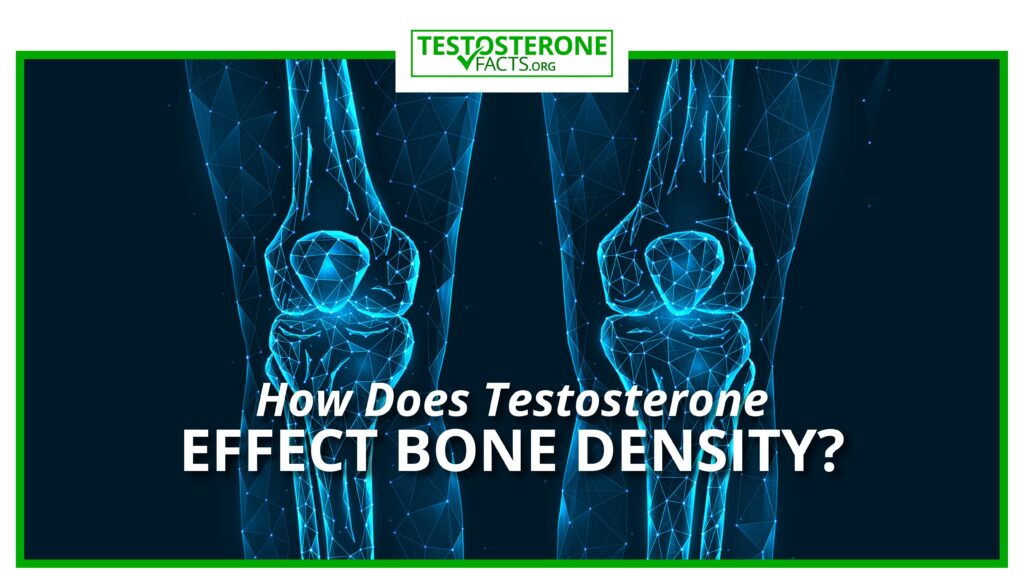
How Does Testosterone Effect Bone Density
- TFacts Staff

We often take bone health for granted until there’s a problem, like a fracture or osteoporosis. But did you know that hormones, especially testosterone, play a crucial role in keeping our bones strong and healthy? Testosterone, commonly known for its role in muscle mass and male characteristics, is also a key player in maintaining bone density. Whether young or old, male or female, testosterone significantly impacts bone health.
In this article, we’ll explore how testosterone influences bone density, what happens when levels are too low, and how treatments can help keep bones strong.
Table of Contents
ToggleWhat Is Bone Density?
Bone density, also known as bone mineral density (BMD), refers to the amount of bone mineral in bone tissue. It is measured by the concentration of minerals, primarily calcium and phosphates, within a given volume of bone.
This density reflects bones’ strength and structural integrity, crucial for supporting the body’s weight and facilitating movement. Higher bone density typically means stronger bones, whereas lower bone density can indicate weaker bones, increasing the risk of fractures and conditions like osteoporosis.
Strong bones protect vital organs, provide structure and support, and facilitate mobility. They also play a critical role in producing blood cells and storing minerals. Conditions like osteoporosis, characterized by low bone density, can lead to severe health complications, chronic pain, and loss of independence.
Factors Affecting Bone Density
Genetics plays a foundational role in determining one’s potential for bone density. As individuals age, bone density naturally decreases, making older adults more susceptible to fractures.
Sex hormones, such as estrogen and testosterone, significantly impact bone density, with declines in these hormones often leading to decreased bone strength.
Nutritional factors, including adequate intake of calcium and vitamin D, are crucial for bone health. Regular weight-bearing exercises stimulate bone formation and help maintain bone density.
Lifestyle choices, such as avoiding smoking and excessive alcohol consumption, also play a role in preserving bone health.
Key Hormones Affecting Bone Density
Estrogen is a key hormone in maintaining bone density, particularly in women. It inhibits the activity of osteoclasts, the cells responsible for bone resorption, thereby reducing bone loss.
Testosterone stimulates the activity of osteoblasts, the cells responsible for bone formation, promoting bone density.
Parathyroid Hormone (PTH) is crucial in regulating calcium levels in the blood and bones. It stimulates both the release of calcium from bones and the absorption of calcium in the intestines, ensuring sufficient calcium is available for various bodily functions.
Testosterone and Bone Density
Testosterone plays a critical role in maintaining and enhancing bone density through several mechanisms:
Stimulation of Osteoblast Activity: Osteoblasts are the cells responsible for bone formation. Testosterone stimulates these cells to produce new bone tissue, contributing to bone growth and increased density. This anabolic effect helps maintain bone strength and reduces the risk of fractures.
Inhibition of Osteoclast Activity: Osteoclasts are the cells responsible for bone resorption, breaking down bone tissue, and releasing minerals into the bloodstream. Testosterone helps inhibit the activity of osteoclasts, thereby reducing bone resorption. By balancing the activity of osteoblasts and osteoclasts, testosterone helps maintain bone density.
Influence on Bone Remodeling: Bone remodeling is a continuous process where old bone tissue is replaced with new tissue. Testosterone is vital in this process, ensuring that bones remain strong and resilient. It helps coordinate the actions of osteoblasts and osteoclasts, promoting the formation of new bone while minimizing bone loss.
Interaction with Vitamin D and Calcium: Testosterone enhances the absorption and utilization of calcium and vitamin D, which are crucial for bone health. Calcium is a primary component of bone tissue, while vitamin D is essential for calcium absorption. By properly using these nutrients, testosterone maintains healthy bone density.
Testosterone Deficiency and Bone Health
Testosterone deficiency, also known as hypogonadism, can result from various factors. Aging is a natural cause, as testosterone levels typically decline gradually after the age of 30. Medical conditions such as Klinefelter syndrome, undescended testicles, mumps orchitis, and hemochromatosis can also lead to low testosterone levels.
Additionally, damage to the hypothalamus or pituitary gland from tumors, infections, or head injuries can disrupt testosterone production. Lifestyle factors, including obesity, chronic stress, poor nutrition, and substance abuse (especially alcohol and opioids), can contribute to reduced testosterone levels. Certain medications, such as corticosteroids and anabolic steroids, may also impact hormone levels. Understanding these causes is crucial for diagnosing and managing testosterone deficiency effectively.
Effects of Low Testosterone on Bone Density
Low testosterone levels significantly impact bone density. Testosterone stimulates osteoblast activity, promoting bone formation. When testosterone levels drop, osteoblast activity decreases, reducing bone formation.
Simultaneously, testosterone’s inhibitory effect on osteoclasts diminishes, resulting in increased bone resorption. This imbalance between bone formation and resorption leads to a net loss of bone density.
Individuals with low testosterone levels are at a higher risk of developing osteopenia (reduced bone mass) and osteoporosis (severe bone loss). These conditions increase the susceptibility to fractures, particularly in the hip, spine, and wrist. Men with hypogonadism often experience significant bone loss, making early diagnosis and intervention critical.
Osteoporosis and Other Bone Disorders Linked to Low Testosterone
Osteoporosis is the most well-known bone disorder associated with low testosterone levels. Characterized by weakened bones and an increased risk of fractures, osteoporosis significantly impacts quality of life and mobility.
Men with testosterone deficiency are particularly vulnerable to this condition, as they lack the hormonal support necessary to maintain bone density. In addition to osteoporosis, low testosterone can lead to other bone-related issues, such as osteopenia, which precedes osteoporosis and indicates early bone loss.
Bone fragility and an increased incidence of fractures are common in individuals with low testosterone levels. Additionally, low testosterone can contribute to sarcopenia (loss of muscle mass), further exacerbating the risk of falls and fractures.
Testosterone Replacement Therapy (TRT)
Testosterone Replacement Therapy (TRT) is a medical treatment designed to restore normal testosterone levels in individuals with low testosterone or hypogonadism. TRT aims to alleviate symptoms associated with testosterone deficiency, such as fatigue, decreased libido, muscle loss, mood changes, and, crucially, reduced bone density. The therapy involves supplementing the body with exogenous testosterone to achieve and maintain physiologically normal levels, improving overall health and well-being. TRT is typically considered when lifestyle changes and other treatments fail to restore adequate hormone levels.
Read more about Alternatives To Testosterone Therapy – A Medical Perspective here at Testosterone facts.
Benefits of TRT
One of the primary benefits of TRT is the enhancement of bone density, which helps reduce the risk of osteoporosis and fractures.
TRT promotes muscle growth and strength, improving physical performance and reducing the risk of sarcopenia (muscle loss).
Many individuals report improved mood, energy levels, and cognitive function with TRT.
TRT can significantly improve libido, erectile function, and overall sexual satisfaction in men with low testosterone.
Risks of TRT
Some studies suggest that TRT may increase the risk of cardiovascular events, such as heart attacks and strokes, particularly in older men or those with preexisting heart conditions.
TRT can stimulate the growth of the prostate, potentially increasing the risk of benign prostatic hyperplasia (BPH) and possibly prostate cancer, though this risk remains controversial.
TRT can increase red blood cell production, leading to a condition called polycythemia, which can increase the risk of blood clots.
Potential side effects include acne, sleep apnea, breast enlargement (gynecomastia), and fluid retention.
Conclusion
Testosterone plays a vital role in maintaining bone density and overall bone health. Its influence extends from stimulating osteoblast activity to inhibiting osteoclasts, thereby ensuring a balanced bone remodeling and mineralization process. For those affected by low testosterone, TRT can be a valuable tool in preserving bone density and overall quality of life, provided it is managed with diligence and medical guidance.
Related Questions
1. What are the symptoms of low testosterone related to bone health?
Symptoms of low testosterone that can affect bone health include increased susceptibility to fractures, back pain, loss of height over time, and general weakness. Low testosterone may also lead to conditions such as osteoporosis, characterized by brittle and fragile bones.
2. How can I know if I have low testosterone levels?
A diagnosis of low testosterone is typically made through blood tests that measure hormone levels. Symptoms such as fatigue, reduced muscle mass, decreased libido, and mood changes may prompt a healthcare provider to check testosterone levels. Know more here: How to check testosterone level.
3. Can TRT reverse osteoporosis caused by low testosterone?
TRT can help improve bone density and may slow or halt the progression of osteoporosis. While it may not completely reverse established osteoporosis, it can significantly reduce the risk of fractures and improve overall bone health.
4. What should I expect during TRT monitoring for bone health?
During TRT, regular monitoring by a healthcare provider is essential. This includes periodic blood tests to check testosterone levels, bone density scans (DEXA scans) to assess bone health, and monitoring for potential side effects or adverse reactions to the therapy.
5. Can testosterone supplements be used as an alternative to TRT?
Testosterone supplements, such as over-the-counter herbal supplements, are not a substitute for medically supervised TRT. These supplements are often not regulated and may not be effective or safe. Know more about Testosterone Supplement Reviews here.




